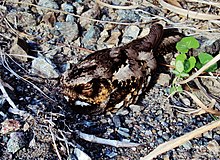|
Philippine nightjar
The Philippine nightjar (Caprimulgus manillensis) is a species of nightjar in the family Caprimulgidae. It is endemic to the Philippines. Its local names are kandarapa (Tagalog) and tagolilong (Cebuano).[2] Its natural habitats are tropical moist lowland forest, tropical mangrove forest, and or tropical moist montane forest. Description and taxonomy Ebird describes it as "A medium-sized night bird of forest and open areas from the lowlands to the mountains. Heavily patterned in various shades of brown, with finely barred underparts, blotching on the chest, and dark wings with large pinkish and white spots and a broad pale bar bordered with black. Note the white lines on the side of the throat with a black line below, and the broad white band on the end of the undertail. Voice is a distinctive, loud two-noted “pyok prraw,” the second note slightly lower and with a vibrating quality."[3] This species is monotypic. Ecology and behaviorKnown to feed on insects while in flight. Otherwise not much is known about its diet. Nests on the ground without creating any structures. Lays one to two oval and splotched brown eggs, typically in the months of April to June which is the breeding season for most Philippine birds [4] Habitat and conservation statusHas a diverse range of habitats from primary and secondary lowland and montane forest, pine forest and second growth, scrubland, beaches and even agricultural lands. Recorded from sea-level to 2000 meters above sea level. The IUCN has classified the species as being of Least Concern where it is said to be locally common. While the Philippines has faced masive deforestation, this species adaptability has allowed it to survive better than other Philippine forest birds.[5]  References
|
||||||||||||||||||||||||||||||||

